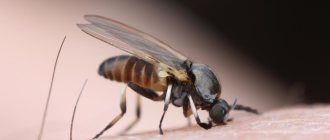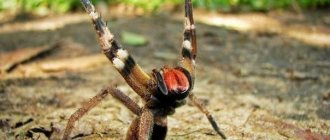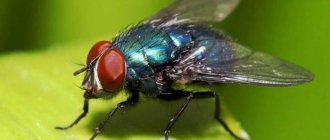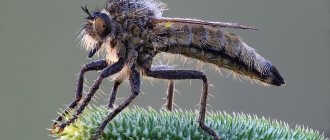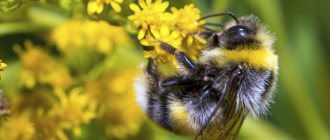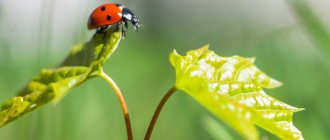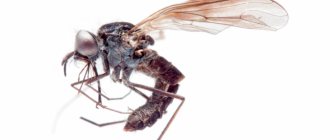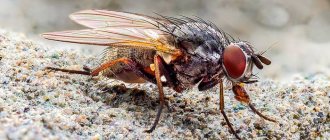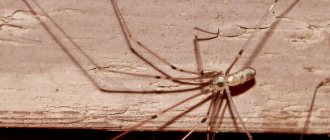The order of Diptera surprises with the variety of representatives. A close relative of the common fly is the ktyr, a ruthless hunter of small and medium-sized insects. A strong body, strong limbs with spikes, a tough proboscis and poison - nature has armed the predator with all this. The moth fly lives all over the world, excluding Antarctica. The exterminator of annoying insects provides a great service to people. But the widespread use of insecticides threatens the existence of beneficial species, some of which are included in the Red Book.
Description
Ktyr is a large family of winged predators. The genus Asilidae belongs to the order Diptera, suborder Short-whiskered. The family of ktyri arose back in the Mesozoic era; today it has more than 7,000 species. A characteristic feature of the structure of the imago is a massive mesothorax and an elongated abdomen. The body shape depends on the species, but in any case it is elongated and cylindrical. Insects living in temperate climates reach a length of 3-50 mm, representatives of tropical species grow up to 80 mm.
The color of the predator is most often black; there are species with brown, reddish or red sclerites. The body is covered with gray pollen; some individuals have a pattern of light stripes and spots. The head is large, almost spherical in shape. Most of its lateral surface is occupied by complex compound eyes. The forehead is depressed, and there are three simple ocelli on the crown. The antennae are shortened. The lower part of the face grows bristles called a beard. They cover the proboscis. This structure helps protect the organ from damage if the victim fights back.
Interesting fact. The head and chest of the ktyri are connected by a movable neck. Some insects can turn their heads 90°.
The strong, developed muscles of the mesothorax provide powerful flight and the ability to capture prey with its limbs. In most species, this part of the body is covered with bristles, hairs and pollen. The wings are well developed, their color varies from transparent to red, brownish and black. The legs are long, massive, covered with bristles. The photo shows that the limbs of the ktyr are adapted by nature to capture and hold prey. Males may have a cluster of contrasting black and white hairs on the fore tibiae.
Nutrition and toxicity
The fly is a ruthless predator that feeds on aphids, locusts, and butterflies. She consumes anything smaller in size in excessively large quantities. Fortunately, the insect does not pose a danger to pets or humans, although it can bite.
Hunts for insects in flight, capturing prey with strong paws, and using the proboscis to direct poison, immobilizing the victim. He delivers blows very cunningly, identifying the weakest points so as not to waste a lot of energy. Immobilization occurs thanks to an enzyme in the saliva: it thins the blood, and the fly quickly devastates the victim.
The contained neurotoxin often leaves larger individuals such as bees and wasps no chance of survival. Opponents will fight seriously, but under the influence of the poisonous saliva of the ktyr it is difficult to defeat. The insect is famous for its patience - it sits in ambush for a long time, carefully choosing a victim.
Lifestyle
The insect ktyr is known for the habits of an aggressive predator. It feeds on small insects, which it lies in wait for and catches in flight. The fly, called the robber and murderer, can rarely be found carelessly sitting on a branch. If she is not in flight, then she chooses her next victim. The predator's diet includes many types of insects:
- flies;
- dragonflies;
- grasshoppers;
- beetles;
- wasps and bees;
- butterflies.
Ktyr prefers dry places and settles in steppes and meadows. Rarely flies into parks and gardens. Having noticed the prey, he rushes after it. The insect has no chance of escaping from a swift attack. The ktyr kills the caught victim with poison. Its proboscis wounds like a stiletto, and its salivary glands release a potent poison that instantly kills its prey. It contains substances that break down the insides of insects.
The predator can only suck out the nutritious cocktail with its proboscis. Large eyes are also invaluable when searching for food and observing enemies. Predatory birds are divided into several groups depending on hunting areas. They are found everywhere - above the ground, in the grass, above the grass, in the trees.
Attention. A caught roach is very aggressive and can bite a person. The sting of its proboscis is comparable to the sting of a bee.
Reproduction
After fertilization, females lay light-colored eggs up to 2 mm in size. In soil-laying species, the ovipositor has spines and bristles. Females place eggs in various places - on low plants, in crevices of the bark, cracks in the soil. The top of the masonry is covered with special mealy secretions. The larva is white or yellowish, elongated. In the front part of the body there are mandibles (jaws) in the form of hooks. The larva develops in the soil and feeds on rotting organic matter. This is where she pupates.
Fly larvae
But people sometimes don’t even remember about the most terrible insect, which is a genus of flies, and maybe they don’t even know at all. Someone heard it, but did not attach any importance to it, although this should not be forgotten, even in the most secluded corner of the earth. After all, this terrible insect called a fly, the product of evil itself, is a real killer and cannibal. A terrible death awaits anyone who ever falls into the clutches of this insidious creature.
BotFly translates as Fly Larva , although it belongs to the same Gadfly family, but is divided into many varieties. Some insects adapt to animals, where they begin their deadly reproduction.
[CHOSEN FOR YOU] 20 unexpected facts about animals that may stun you
For example, Horse Stomach Bot Fly, a horse-eating fly, lays its parasitic eggs in pastures where herds of horses graze.
Bays and blacks swallow these eggs along with food, thereby becoming a living incubator for these creatures. Having penetrated the animal, the larvae begin to build nests right in the stomach and intestines of the poor horse, they feed intensively and grow, making and gnawing passages into other organs. Unhappy animals usually get sick and die. When the time comes for a fat and well-fed larva to become a fly, they crawl out and give birth to monsters.
Giant ktyr
One of the large species of the family is called the giant blackbird or Satanasgigas. The genus of predatory flies with the eloquent name “Satan” includes insects exceeding 50 mm in size. The length of the giant, despite the name, is quite modest: 28-51 mm. The body is covered with a gray coating, the proboscis is shorter than the head. The larvae develop in the soil; this stage lasts about a year.
Satanasgigas lives in deserts and semi-deserts in northern Africa, Mongolia, Central Asia, Kazakhstan, and southern Europe. Its presence is noted in Ukraine, Russia, Greece. The giant moth was once included in the Red Book of the USSR; now the insect falls under protected status only in Ukraine.
Features of hunting
The greatest activity is noticeable at temperatures above 20°C in low windy weather before evening - this is the ideal time for hunting. Flies usually sit on plants, and if the wind is too strong, then on the soil.
These insects choose a specific area to hunt. Having found a good place, they spend a lot of time there. Often the territory is occupied by one robber, but sometimes several of them live there.
In addition to dangerous poison, the predator has halteres, which give it the ability to perform maneuvers in the air. She is also called a professional pilot in the world of insects.
Homemade traps
A person often uses his ingenuity to achieve certain goals. The fight against insects was no exception. Annoying flies can make even the calmest person angry. To kill insects, especially enterprising people make homemade traps.
Trap made from a plastic bottle
Trap made from a plastic bottle
To make a homemade product, you will need a regular plastic bottle with a volume of 1 or 1.5 liters, scissors or a knife, any sweet filling, and tape.
- The top part of the bottle is cut off at a distance of 7-8 cm from the edge of the neck.
- Bait is placed at the bottom of the resulting container: jam, honey, syrup.
- The cut off funnel-shaped neck is inserted into the container, neck down.
- The wide edge of the funnel and the top edge of the container are fixed with tape or tape.
On a note!
The narrow edge of the neck should not touch the sweet filling. Flies should not get the sweetness without flying inside the bottle.
Such a fly trap made from a plastic bottle can also catch other insects with a sweet tooth: wasps, bees, midges. A simple and affordable method of making a trap allows you to throw it away if there is a large accumulation of insects inside and make a new one.
Flycatcher from a glass
You can make a fly trap from a regular glass or plastic cup and transparent cling film. Place a teaspoon of honey or jam at the bottom of the glass. Cover the glass with cling film and pull it tightly, securing the edges of the film with tape. Make 2-3 holes in the film so that the insect can get inside the glass. You can make several of these homemade items and place them throughout the house.
Glass jar trap
In places where large flies accumulate, you need more serious bait - spoiled meat or fruit. They have a strong strong odor and will attract more flying gnats.
- A liter glass jar with a wide neck is used as a container.
- Several pieces of bait are placed inside.
- A wide funnel is placed on top with the narrow neck down.
- The edges of the container and the wide edges of the funnel are secured together with electrical tape or wide mounting tape for structural reliability.
On a note!
The strong smell of rotten vegetables, fruits or meat will be very unpleasant for household members and interesting for cats and dogs. Therefore, it is recommended to use such a flytrap to catch flies on open verandas and place it in places inaccessible to animals.
Instead of a glass container, you can use a thick plastic container with a wide neck. The main condition for a reliable flytrap is the absence of gaps between the funnel and the jar. Otherwise the flies may crawl out. Such traps are well suited for use in dachas if they are placed around the perimeter of the site.
Duct tape
Fly tape
One of the most popular fly traps is sticky tape. It is sold in any hardware store and costs from 20 to 50 rubles per piece. But if it is not possible to purchase the product in a store, you can do it at home. To do this, mix 1 tablespoon of rosin with a tablespoon of castor or linseed oil. Heat the resulting mixture in a water bath and stir for 5 minutes. Then add jam and cool. Apply the adhesive mass to long strips of thick paper and hang it in places where flies are common.
If you follow the recipe, homemade glue remains sticky for a long time and is able to reliably hold insects attracted by the smell of jam.
Struggle
Dealing with the cherry fly is not easy. Even if you show maximum responsibility, much will depend on your neighbors who grow stone fruit trees.
Bright yellow-orange pupae are easy to detect in tree trunk circles at a depth of about 7 cm. To get rid of most pests, it is enough to dig up the soil in the crown projection in the spring and manually collect all the discovered pupae. Experienced summer residents advise repeating the procedure at least 2-3 times throughout the warm season.
The final autumn digging will help to finally consolidate the result. An alarmed pest that suddenly finds itself near the surface will be absolutely defenseless against the approaching cold weather. Almost everything that you miss when picking by hand will be killed by frost.
If only a few pests infest your area, hang traps with kvass, compote or honey water from the branches of stone fruit crops, which have already become acidic and have begun to ferment. Cherry flies will not be able to resist the heady aroma of fragrant mash, just like cats will not be able to resist valerian. The pest will land directly “on the water” and drown “without leaving the cash register.”
For one mature tree you will need to install about 5 traps in different parts of it. Periodically, the traps will need to be cleaned and the syrup inside them renewed.
For a more radical method of control, gardeners use tobacco infusion. For 10 liters of water take about 500 g of tobacco dust. The composition should be infused for 2 days, after which it is filtered, 50 g of grated household oil or 3 tbsp are added. l. liquid soap to ensure better adhesion. They treat both the crown itself and the soil underneath it.
Well, if the pest is “on the rampage”, you will have to resort to special products sold in specialized stores - “Aktara”, “VE”, “Iskra”, “Fufanon”. The treatment is carried out in 2 stages, following the instructions, at intervals of 2 weeks.
How to get rid of bloodsucker
To prevent moose flies from getting on your body, you need to dress properly when going into the forest. There should be no open areas on the body, a jacket, trousers with tight cuffs, and a hat.
When you get home, throw all your clothes in the wash because moose flies may stick to them. Examine the body. If you find a pest, throw it into the fire or a jar of alcohol, then throw it away. Take a shower, wash your hair, comb your hair thoroughly.
Insecticidal repellents are used to protect against deer bloodsucker. Any remedy for ixodid ticks, flies, and fleas is suitable. Effective drugs - Taiga, Raptor, Raid, Off, Cypermethrin 25.
Regarding animals, it is completely impossible to prevent pest attacks, but the timely reaction of the owner and the adoption of emergency measures protect the livestock from serious consequences. Use repellents or folk remedies.
Moose fly bites are treated in the same way as other harmful insects. Wipe the sore spot with ice cubes, medical alcohol, ammonia, aloe juice, and chamomile decoction. Lubricate with Zvezdochka balm and Menovazin. If there is an allergic reaction, take antihistamines and treat sore spots with antiallergic ointments.
Prevention
The incidence of sleeping sickness has decreased significantly in recent years, which is associated with increased prevention. They try to avoid tsetse habitats and dangerous areas - tropical bushes, agricultural areas.
If flies bother you in the house, insect repellents are used, and they act on individuals of various species. Methods to combat tsetse include treating clothing with permethrin. You can get rid of insects that traditionally settle in the house in more accessible ways. A reliable means of repelling flies is vinegar traps. Wine is used instead of vinegar.
If a biting fly ignores sticky tape and light traps, essential oils will help. The aromas of cloves, basil, and lavender can drive a fly out of the room. And regular cleaning is considered a reliable way to get rid of flies in an apartment. If the room is clean, the floors are washed, the drains are cleared, and there are no food residues, then the insects will be uncomfortable in the house.
Dear readers of the 1MedHelp website, if you still have questions on this topic, we will be happy to answer them. Leave your reviews, comments, share stories of how you experienced a similar trauma and successfully dealt with the consequences! Your life experience may be useful to other readers.
Types of hoverflies
The most common types of hoverflies that can be found in our gardens are useful, and only the onion one is an undoubted pest. Below are examples of the most common flies of this family:
- Onion, in Latin "Delia antique", has a size of up to a centimeter in length. The eggs laid in the axils of the leaves hatch into larvae that damage the bulbs, causing them to rot.
- Aquatic hoverflies, or "Eristalis", feed near stagnant water in small natural pools and marshes. The proboscis on their body, like a diver's breathing tube, helps them breathe under the surface of the water.
- The common hoverfly is a flower fly that reaches twelve millimeters in length. Its larva can eat up to two hundred aphids per day. The common hoverfly is an excellent pollinator. The camera captured her on clover
- The wasp fly is most similar to a wasp, hence its name. Its larvae feed mainly on rotten wood, and the adult grows up to eighteen millimeters in length.
- The hoverfly is a little smaller, only one and a half centimeters long, has a darker color and, as its name suggests, resembles a bee.
Vulnerability of plant predators
The life led by a flower that eats flies is not so simple in itself. An insect that is not grabbed very well and tightly is quite capable of escaping from the trap. And even if it dies later, the plant predator will remain hungry. Plus the realities of civilization: in the modern world, it is precisely those qualities that have been developed over millennia that can destroy flowers that eat flies. Nitrogen fertilizers washed away from fields and discharges from power plants oversaturate the swamp soil with nitrogen, which kills plant predators. The second threat from which they cannot protect themselves is poaching. The increased demand for carnivorous plants in recent years has encouraged adventurers to seek out wild Venus flytraps and sell them almost on the side of the road. Those copies that remain “in the hands” of sellers are indifferently thrown away. In addition to all these troubles, the result of land development is the disappearance of the habitat of predator flowers. So, it is quite possible that in the next half century they will remain only in greenhouses and home collections.

